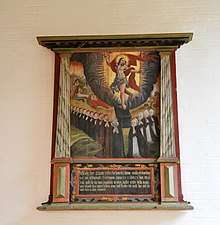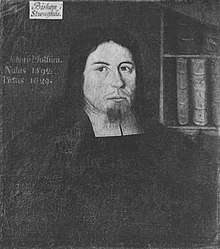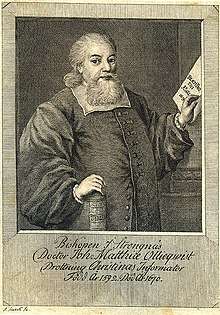Johannes Matthiae Gothus
Johannes Matthiae Gothus (born 29 December 1592 in Västra Husby - died 18 February 1670 in Stockholm) was a Swedish Bishop and an Uppsala University professor, the rector of the Collegium illustrious in Stockholm (1626–1629) and the most eminent teacher in Sweden during the seventeenth century. He was Bishop of Strängnäs from 1643 to 1664.
Gothus embodies like no other Swedish clergyman during the confessional era the continuity and renewal of the Reformed Evangelical humanist tradition in Sweden. He had close connections with the Swedish royal house and with European reform circles; he was a keen friend of both Comenius and John Dury. In doing so, he exerted influence on the so-called folk teaching (school order 1649) and on church organisational issues. In particular, he was the spokesman for a so-called ecumenical, European religious policy. His fate was therefore sealed when, with the guardianship of 1660, the ecclesiastical cycles changed. He was then forced to resign from the position as Bishop. As a man of ecunemism, Gothus' has a special position among Swedes. Only finding an equal threehundred years later in Bishop Nathan Söderblom.
Family
Gothus was the son of the vicar Matthias Petri Upplänning (1533-1610) and Anna Danielsdotter Grubbe, the daughter of Daniel Jonsson Grubbe, the mayor of Norrköping. Matthias Petri Upplänning's ancestors had been part of the old Upplandian nobility. One source claims that "Bishop Johannes Matthiae's grandfather's mother was Birgitta Vasa, a cousin of king Gustav Vasa. Gothus had 14 siblings, one of whom was the merchant in Söderköping Peder Mattsson Stiernfelt.

Gothus first marriage was to Catarina Nilsdotter Bohm, the daughter of chamberlain of Kammarkollegiet, The Legal, Financial and Administrative Services Agency, Nils Olofsson Bohm and Karin Pedersdotter. The marriage itself took place at the Royal Palace in Stockholm in the autumn of 1634. His second marriage was to Beata Nilsdotter Lillieram, daughter of chancellor Nils Chesnecopherus Lillieram, which possibly took place at Rockelstad Castle in 1659.
The descendants of Johannes Matthiae Gothus were introduced at the Riddarhuset, Swedish House of Nobility in Stockholm, under the name Oljeqvist as noble family number 331.
Children:
- Christina Johansdotter
- Johan Johansson Oljeqvist
- Gustav Johansson Oljeqvist
- Anna Johansdotter Oljeqvist
- Nils Johansson Oljeqvist
- Karin Johansdotter Oljeqvist
- Kristina Johansdotter Oljeqvist
- Elisabeth Johansdotter Oljeqvist
- Maria Johansdotter Oljeqvist
- Petrus Johansdotter Oljeqvist
- Carl Johansson Oljeqvist
- Maria Johansdotter
- Katarina Johansdotter Oljeqvist
Career
Early Life and Education
Gothus' special position among the clergy is explained by his unique life course. He grew up in a milieu that was shaped by Duke Charles's struggle against Sigismund, the high nobility, the priesthood and the practical-religious problem associated with immigration of foreign labor in the mountain management. His father, who was a church pastor in Söderköping, had, as one of the priesthood delegates, signed the Söderköping Arvsförening in 1590, his 20-year-old brother was a pastor of Duke Charles in 1597, and since 1599 the church pastor in Norrköping, where the Confederate Confederate's through a wide-eyed congregational care assimilated the reformed population. Like Duke Charles, later Charles IX of Sweden, Gothus' came to work for an evangelical-humanist church reform and to meet the opposition from the clergy.
During a ten-year study period, beginning in 1599 in Linköping, Gothus experienced Linköping Bloodbath and Norrköping's Arvsförening. Once the stormy decade of the 1590s had come to an end, he enrolled at Uppsala university. Upon enrolling, he immediately joined the pious religious controversy of the compatriot, the educated Johannes Messenius of Braunsberg's Jesuit College, who was in conflict with the intrusive scholastic confessional representative Johannes Rudbeckius. During his study stay in Uppsala, he received further impulses that would guide him in his independent spiritual direction. He enjoyed financial support from the East Gothic court circles and the bourgeoisie, from John of Sweden, Duke of Östergötland and his wife, king Gustav II Adolf's sister and High Councillor Johan Skytte. His humanistic religious orientation is reflected in his poetic studies under Messenius, in whose dramas he acted, in his dissertations in ethics and in his position as informant of his relatives, the sons of Lutheran-Melanchthonic Archbishop Petrus Kenicius.
After studying in Uppsala, Gothus' came, in no less than seven years, between 1618 and 1625, to have Europe as his university. He made his first foreign study trip in 1618 to 1620, mainly to the Hessian university in Giessen. He deepened his piety focus during studies for the major ethical-religious-oriented theologian, university, church and school reformer Balthasar Mentzer.Gothus made only a brief guest visit to his Sweden between his two long foreign trips during which he, in 1621, was appointed professor poesos at Uppsala university.
His second course of study was crucial to his life's work. In spite of all Lutheran-confessional regulations and scholastic-theological educational goals, he was exposed and deepened himself in the ethico-religious renaissance during his visits to Holland, England and France, not least in England, where there was a reaction to Calvinist neo-confessionalism, which prevailed at the Synod of Dort in 1619, and which Gothus' himself faced in a dissertation in Giessen.
Professorship and Rectorship
By the time Gothus returned home at the age of 32, he was a mature man with European broad-mindedness like no other Swedish theologian. He immediately became professor of theology at Uppsala University and rector and professor of the newly founded Collegium Illustre in Stockholm. At the time of the House of Knight's establishment, the king Gustavus Adolphus realised that the nobility needed education in order to maintain their position. Already in the preamble of the knight house order, the long-gone plans of a special school, exclusive to the nobility and located at the knight house, were clarified.
This teaching work was subsequently established in 1626 and was initially a success. The seven-year schooling, was the idea, would prepare the noble youngster for a career in the top tier of the kingdom. Later Bishop Johannes Matthiæ Gothus was appointed professor and principal. One of the school's facilitators, the Swedish National Council Johan Skytte, had the room decorated for teaching and published textbooks. Gustavus Adolphus, who sometimes heard about the school's disputes, promised on April 24, 1627, an annual grant from the state funds for this so-called Collegium illustre on 2,000 dollars silver coins. The rest of the costs were taken out of the knight's house.
The Swedish Council, Johan Skytte, had the main leadership in its establishment and governance. Gothus provided the curriculum, Ratio studiorum; Plan of Studies. One of the most characteristic features of humanistic pedagogy was the practice of keeping notebooks; schoolboys were encouraged to compile commonplace books for reference use when they could read and write reasonably accurately. Ratio Studiorum lavishes praise on notebook practice. Like numerous humanistic teaching programmes, it suggests tha students should excerpt sentences, proverbs, similes and other literary elements, write them down in a notebook and memorise them. According to Gothus, a schoolboy should begin at the age of eight with moral sentences of Publilius Syrus, Terence, Seneca, Cato and Cicero; at the age of ten, he should be introduced to sentences by Greek authors, first in Latin translations, later in the original Greek version.
The educational system consisted of a lower and a higher department. In the lower, which was seven-class and intended for children between seven and fourteen years of age, teaching was preferably communicated in the classical languages and French; in the higher, "auditorium publicum", lectures were held in philosophy, mathematics and eloquence. The intention was, in time, to include lectures that also cover theology, law and medicine or, in other words, to form a full university in the capital. At the college, disputes were published and defended. The number of professors was three. The first teachers were: Johannes Matthiæ Gothus, author of the above-mentioned curriculum and finally bishop of Strängnäs diocese, Vilhelm Simonius and Jöran Lilja alias Georg Stiernhielm and, after his departure in 1628, Jacobus Boose Rudbeckius. Once at school, each day began and ended with prayer and Bible reading. In between, lessons were held in both classical and modern languages such as dialectics, rhetoric, physics and mathematics. Exercises were an important element in which teaching of singing, dance and instruments was interspersed with more warlike training in the preparation of troops as well as martial and equestrian art. Among the celebrities who attended the school were among the teachers Jöran Olofsson Lilja, later known as the bald Georg Stiernhielm, and among the students the future field master Carl Gustaf Wrangel.
The teachers' salaries were paid partly by the state (annual appropriation of 2000 dollars of copper coins, according to the royal letter of 27 April 1627) and partly by the knight house fund. The plague in 1629 interrupted the college's activities. At the same time, Johannes Matthiæ Gothus and Simonius were drawn to other fields of work. Rudbeckius was retained at work and pay until 1632, when his resignation college completely ceased. Collegium illustrations came to be short-lived. In 1629 the plague ravaged Stockholm and the nobility left the city. The lecture rooms were empty and the teachers undertook other assignments. It was formally dissolved three years later.

Court Pastor and Military Bishop
Johannes Matthiae Gothus was appointed court pastor. In 1630-32 he accompanied king Gustavus Adolphus during the German campaign as field bishop in the Thirty Years' War and was responsible for the ecumenical negotiations with Durie, which he completed during his stay in Sweden as an English envoy in 1636-38. During his time in Germany, he was, among other things, responsible for stocktaking of the books of Worms and many other cities. He had enjoyed Gustavus Adolphus full confidence and was appointed by him to deal with Kristina's upbringing (1633–43) with all the delicate religious-personal and ecumenical problems this involved with reformed family relations within the country and intended reformed goal for the young queen, both the current reform pedagogy and his foreign experience at the church board organisation.
In the conflicts surrounding Joannes Baazius and Johannes Rudbeckius during these years, he stands by his Presbyterianism close to Baazius parish and in his aristocratic episcopalism the accused of his freedom of the church J Rudbeckius. At the same time, he differs from both Baazius state church view and the bishops' confessional stance through his humanistic view of the Christian king's and laymen's role in the church. His reform pedagogy is expressed in his curriculum in 1626, in his textbooks in 1627 and 1635, and above all in his catechetical textbooks. In these, his ethico-religious anti-denominational basic view and dependence on Western European laymanism are expressed, as well as in his initiative to found the first Swedish orphanage in Stockholm in 1633. A theological analysis shows that there is an ethico-religious continuity between his lus puerilis 1626, his Institutio religionis christianae 1642, in which he presents the teaching he gave to Kristina, and his writings after Kristina's conversion to Catholicism, his dogmatically set work Regula credendi et vivendi, 1656, in which he defends himself against the accusation of being responsible for Christina's apostasy, and his Sum then overcomes pure salvation of Catholic Christian doctrine, where in 1656 he gives Kristina her pastoral care (cura animarum) for her Rome stay.
Queen Christina's Teacher
After the king's death, a guardian board was appointed, headed by the chancellor, Axel Oxenstierna. Gustavus Adolphus had left instructions for her daughter's upbringing and selected her future governors and preceptors. It was considered of great importance that these were indigenous men - Axel Banér was appointed governor and Gustaf Kristersson Horn af Åminne as sub-governor. The teacher who would have the most long-term influence on the Queen was Johannes Matthiae Gothus who taught her classical languages, science, history and religion. The goals of Kristina's upbringing as regent were regulated by the report of the States on March 24, 1635. Kristina would learn something about foreign customs because they were necessary for her rank and position, but she would "dress up" in the natives in the first place. The essence of her studies would be the word of God, the articles of Christianity, and all Christian virtues. It was emphasised that she would not be infected with "Papacy or Calvinist willpower".
The guardians did everything to realise this command. Kristina was taught male sports, riding and hunting, and nature had not denied her any trait that would have been an honor for a young man. Her intellectual prowess was astonishing. She seemed to have no limits to her ability to acquire knowledge, and her teacher, Johannes Matthiæ, stuffed her full of all kinds of knowledge. She now learned o later to speak o partially write most living cultural languages, French, German, Italian and Dutch, in addition Latin and had knowledge of Greek, Hebrew and Arabic as well. Her scientific interest was mainly focused on classical philology, philosophy, theology, mathematics and astronomy. When Johannes Matthiæ laid the foundation, then came Sweden's greatest statesman, Axel Oxenstierna himself, and introduced her to the duties of public life. Here, too, her powers failed. When she was seven years old, the Swedish queen Gabriel Oxenstierna wrote to Axel Oxenstierna: "Our young queen has an extraordinary stately engineering." A few years later, Axel Oxenstierna in the Swedish National Council stated: "Her Royal Majesty lets her see specimens about her gender and age!"; "God knows how dear it is to me to see that Her Majesty is not like a woman person, but with a good sense of the good."
On Dec 8, 44, K was born. She was eighteen years old then. Some time later, French diplomat Pierre Chanut drew a picture of her. He is full of admiration. She speaks French, as if she were born in the Louvre, or Latin as her native language, he writes; she loves poetry, literature and books, has a rare spiritual agility, a quick, safe, unusually wide-eyed view, is wise and restrained; energetic in her work and constantly in motion, she devotes herself entirely to the occupations of an old statesman or philosopher. In the future, Chanut adds, the so-called queen wants to govern her own country o and strives to acquire practice o experience for this by treading the Council's meetings o carefully taking into account all existing government matters.
Queen Kristina's relationship with her teacher was close; so close, he became like a father to her. She referred to him as father.
Later Career and Disputes

Bishop of Strängnäs
Authorship
Gothus authored numerous writings that spread throughout much of 17th-century Europe. He published at least 92 printed writings, of which 67 were books on religion, seven sermons, four on linguistics, of which one was on Latin grammar, which is still being used in schools in Italy today, three novels and two on education and pedagogy. Of these books, 61 are written in Latin, 28 in Swedish, of which seven are sermons. One book in German, one in Dutch and one in French.
Manors and Estates
Johannes Matthiae received gifts and great fiefs from Christina, Queen of Sweden and the Queen Mother. He owned more than 33 large estates and manors and a number of smaller properties in different parts of Sweden. These were part of the crown payment.
He built Strängnäs Bishop's Palace, which still stands today. Rockelstad castle was in Gothus' possession and thus functioned as a Bishop's palace. He also owned Söderlänna Manor.
Ancestors
| Ancestors of Johannes Matthiae Gothus | |||||||||||||||||||||||||||||||||||||||||||||||||||||||||||||||||||||||||||||||||||||||||||||||||||||||||||||||||||||||||||||||||||||||||||||||||||||||||||||||||||||||||||||||||||||||||||||||||||||||||||||||||||||||||||||||||||||||||||||||||||||||||||||||||||||||||||||||||||||||||||||||||||||||||||||||||||||||||||||||||||||||||||||||||||||||||||||||||||||||||||||||||||||||||||||||||||||||||||||||||||||||||||||||||||||||||||||||||||||||||||||||||||||||||||||||||||||||||||||||||||||||||||||||||||||||||||||||||||||||||||||||||||||||||||||
|---|---|---|---|---|---|---|---|---|---|---|---|---|---|---|---|---|---|---|---|---|---|---|---|---|---|---|---|---|---|---|---|---|---|---|---|---|---|---|---|---|---|---|---|---|---|---|---|---|---|---|---|---|---|---|---|---|---|---|---|---|---|---|---|---|---|---|---|---|---|---|---|---|---|---|---|---|---|---|---|---|---|---|---|---|---|---|---|---|---|---|---|---|---|---|---|---|---|---|---|---|---|---|---|---|---|---|---|---|---|---|---|---|---|---|---|---|---|---|---|---|---|---|---|---|---|---|---|---|---|---|---|---|---|---|---|---|---|---|---|---|---|---|---|---|---|---|---|---|---|---|---|---|---|---|---|---|---|---|---|---|---|---|---|---|---|---|---|---|---|---|---|---|---|---|---|---|---|---|---|---|---|---|---|---|---|---|---|---|---|---|---|---|---|---|---|---|---|---|---|---|---|---|---|---|---|---|---|---|---|---|---|---|---|---|---|---|---|---|---|---|---|---|---|---|---|---|---|---|---|---|---|---|---|---|---|---|---|---|---|---|---|---|---|---|---|---|---|---|---|---|---|---|---|---|---|---|---|---|---|---|---|---|---|---|---|---|---|---|---|---|---|---|---|---|---|---|---|---|---|---|---|---|---|---|---|---|---|---|---|---|---|---|---|---|---|---|---|---|---|---|---|---|---|---|---|---|---|---|---|---|---|---|---|---|---|---|---|---|---|---|---|---|---|---|---|---|---|---|---|---|---|---|---|---|---|---|---|---|---|---|---|---|---|---|---|---|---|---|---|---|---|---|---|---|---|---|---|---|---|---|---|---|---|---|---|---|---|---|---|---|---|---|---|---|---|---|---|---|---|---|---|---|---|---|---|---|---|---|---|---|---|---|---|---|---|---|---|---|---|---|---|---|---|---|---|---|---|---|---|---|---|---|---|---|---|---|---|---|---|---|---|---|---|---|---|---|---|---|---|---|---|---|---|---|---|---|---|---|---|---|---|---|---|---|---|---|---|---|---|---|---|---|---|---|---|---|---|---|---|---|---|---|---|---|---|---|---|---|---|---|---|---|---|---|---|---|---|---|---|---|---|---|---|---|---|---|---|---|---|---|---|---|---|---|---|---|---|---|---|---|---|---|---|---|---|---|---|---|---|---|---|---|---|---|---|---|---|---|---|---|---|---|---|---|---|---|---|---|---|---|---|---|---|---|---|---|---|---|---|---|---|
| |||||||||||||||||||||||||||||||||||||||||||||||||||||||||||||||||||||||||||||||||||||||||||||||||||||||||||||||||||||||||||||||||||||||||||||||||||||||||||||||||||||||||||||||||||||||||||||||||||||||||||||||||||||||||||||||||||||||||||||||||||||||||||||||||||||||||||||||||||||||||||||||||||||||||||||||||||||||||||||||||||||||||||||||||||||||||||||||||||||||||||||||||||||||||||||||||||||||||||||||||||||||||||||||||||||||||||||||||||||||||||||||||||||||||||||||||||||||||||||||||||||||||||||||||||||||||||||||||||||||||||||||||||||||||||||